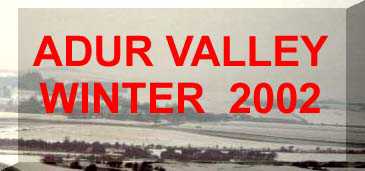WILDLIFE
REPORTS
 30 September
2003 30 September
2003
It
is surprising how full Widewater Lagoon can
look after just a small rise because of the percolation and sea rushing
through the inlet. The water spreads out over the flat flood plain, submerging
most of the Glasswort.
Over
the gravel near the seawater inlet to Widewater a Clouded
Yellow Butterfly flew in the moderate
north westerly breeze on a sunny
16.2 ºC (max) afternoon.
Red
Admiral Butterflies were flying strongly
in the moderate breeze as well as at least one Painted
Lady Butterfly in south Lancing.
29
September 2003
A
large healthy Fox ran
boldly down Dolphin Road, Shoreham, on the houses side of the fence that
borders the railway track that runs parallel with the road at 9:30
pm in the evening. It then trotted into a
garden at about 20-22 Dolphin Road, in the Corbyn Crescent area where I
live. On the moonless light the Fox
appeared
a dusky grey. There are no rabbits around but there is probably a large
population of mice as I have seen then running across the road. Foxes have
occasionally been seen on the railway track and there is the Municipal
Dump in their territory. The Foxes
have been here for years, but I not seen them near the houses before.
The
Hummingbird
Hawk Moth, Macroglossum
stellatarum, is still around in my
Old Shoreham garden.
Moth
Report by Mike Burtt
Previous
Report
Andy
Horton appeared on BBC
Southern Counties Radio to discuss the marine life
of Sussex and the work of the British Marine
Life Study Society.
28
September 2003
A
Comma
Butterfly visited my south Lancing garden,
feeding on Verbena bonariensis.
26
September 2003
The
inlet pipe to
Widewater
Lagoon has not been detrimental to the autumn Glasswort,
Salicornia,
as if anything the splendid and unusual scarlet fringe to the lagoon is
even more dramatic than usual.

Red
Glasswort by the Inlet Pipe
Under
Worthing
Pier on the low equinoctial spring
tide the
fauna was not exceptional but there was plenty of interest, including a
red
Dahlia
Anemone, Urticina felina,
over a hundred Snakelocks Anemones,
Anemonia
viridis, Beadlet
Anemones,
Actinia
equina, and one surprise was a particularly strongly patterned
Daisy
Anemone,
Cereus
pedunculatus, a rare occurrence on the shore in Sussex. There were
six species of Brachyuran crabs including at
least three large Velvet
Swimming Crabs,
two of them with a major claw missing. Star
Ascidian (a sea-squirt) was noticeable
on rocks and 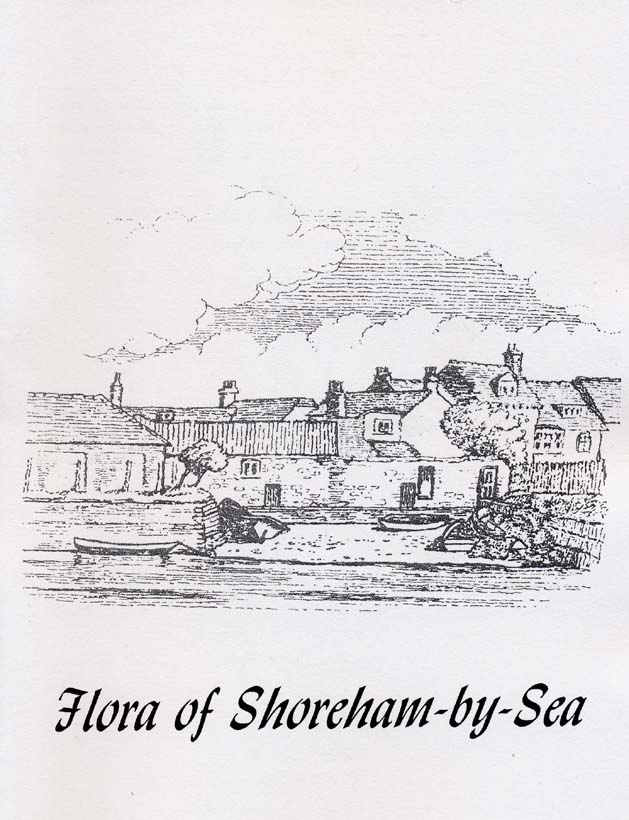 groynes. groynes.
Full
Report
The
small pamphlet "Flora of Shoreham-by-Sea"
by
Betty Bishop, second revised edition 2003 was published today. The price
for the 28 page booklet with a complete list of all the 673 wild flowers
of the area is expected to be about £1.50 to cover the costs of production.
24
September 2003
Still
the summer lingers on, but the temperature of 17.1 ºC on a sunny day
falls below 20 ºC, as expected in the final quarter of the year.
Fresh
Wall
Brown Butterflies some put in an appearance
on the path down to the lower slopes of Mill
Hill. The small moth-like brown flying insects were discovered to be
small
female Common Blue Butterflies and
there were larger male Common Blues
as well.
One
Small
Heath settled with its wings closed and
then a handful of Meadow Brown Butterflies
were identified.
By
the stile that leads on to the overgrazed land, three Clouded
Yellow Butterflies danced around each
other, and I was pleased to see a large party of ramblers on this footpath
which is so often blocked by cows.
Full
Report
On
Lancing beach and in Lancing town there was at least one Painted
Lady Butterfly in each area.
22
September 2003
The
long dry spell is nearly over with 3.05 mm of rain in the early evening,
after a warm afternoon with the temperature reaching 22.6 ºC.
21
September 2003
The
evening Shoreham temperature is 19.3 ºC, and the humidity is 90%.
This is more like a tropical rain forest (temperature about 25 ºC,
humidity 82%).
20
September 2003
A
quick walk around the "Butterfly Trail" at Lancing
Clump and meadows produced two Wall
Brown Butterflies, one feeding on the
late Greater Knapweed flowers,
with two Speckled Wood Butterflies
in the shade, and four or more Common Blue
Butterflies. Common
Darter
Dragonflies,
Sympetrum
striolatum, were around and at least four were spotted.
Lancing
Nature Slide Show Pages (by Ray Hamblett)
19
September 2003
I
dived Shoreham beach by the Church of the Good Shepherd in the early evening
and saw Cuttlefish of all sizes, Sepiola
atlantica and some young squids possibly Loligo vulgaris.

Tub
Gurnard,
Chelidonichthys
lucerna
Photograph
by Paul
Parsons
There
were also shoals of Sand Smelt,
and
other fish: Tub Gurnard,
Undulate
Ray, Plaice and Sole,
Bass
and
gobies!
British
Marine Life Study Society
c.
17 September 2003
A
specimen of the nudibranch Thecacera
pennigera is observed on the Brooklands sea outfall pipe, on
the Lancing/Worthing border, West Sussex. This small sea
slug is probably overlooked and of a sporadic occurrence rather than
uncommon, but this is the first record I have for the local coast, and
I have never seen one on the shore, where it would be notable. The pipe
also provides a home for the sea anemone Diadumene
cincta.
BMLSS
Nudibranchia
The
Sea off Sussex
As
the red sky appeared at dusk in the west; there a few vapour trails but
there was not a single cloud in the sky as the temperature reached 22.9
ºC in the late afternoon with excessive
humidity up to 83%.
This
insect appears to be the Speckled Bush Cricket, Leptophyes
punctatissima, found in my front garden in Corbyn Crescent, Shoreham
(TQ
224 053).
The
flightless cricket hopped very slowly along the concrete path when poked,
but mostly it crawled slowly around. It is undoubtably a very common species.
UK
Grasshoppers & Crickets
Orthoptera:
List of British Species
Shoreham
Town & Gardens
A Merlin,
Falco
columbarius, was seen on
Mill
Hill. The smallest bird of prey is classified as "scarce" and a Winter
Visitor and Passage Migrant in Sussex.
SOS
Birds of Prey
It is
at this time of year that the bird watchers are on the look out for migrant
birds passing through Sussex on their long journeys to warmer climates.
16
September 2003
My
first Migrant
Hawker Dragonfly, Aeshna
mixta, of
the year is seen through binoculars, hawking to and fro and never settling
over the stream by the Steyning Road (TQ 209
068), just north of the A27 Flyover. It had
a dark blue thorax and a brown head.
Full
Report (including Butterflies)
14
September 2003
Off
Worthing, on a shallow water dive site known as the Worthing Lumps, a small
school of Rock Cooks (Small-mouth Wrasse),Centrolabrus
exoletus, were seen shyly swimming by
the rock face, quite unlike the bolder Corkwing,
Symphodus
melops (=Crenilabrus), and Goldsinny
Wrasse, Centrolabrus rupestris.

Rock
Cooks (Small-mouth Wrasse),
Centrolabrus
exoletus
Photograph
by Paul
Parsons
These
inconspicuous wrasse have not been recorded off the Sussex
coast before and the books state that is fish is only known from the southern
and western coasts of Britain. They may have been overlooked, but they
are certainly not a common occurrence. There have been no records of juvenile
fish in Sussex rock pools, where the Corkwing
first year fish are very common and Ballan
Wrasse, Labrus bergylta,
juveniles occasionally discovered.
BMLSS
Wrasse
BMLSS
News 2003
A
deer
jumped and trotted around a field near Applesham Farm on the downs
on the west side of the River Adur, near Applesham Farm, (a private road
leads to the farm on the downs, on the Coombes road leading to Botolphs,
between Cuckoo's Corner and Coombes).
Report
by Mick Bowen
On
a walk through the overgrown Mash Barn Lane, Lancing (leading to New Monks
Farm, Lancing), (from its entrance on the housing estate bearing it's name),
we were almost immediately struck by the profusion of butterflies. On a
fallen Ivy festooned tree, seven Red Admirals
were nectaring on the flowers. As we proceeded through the lane at least
three Speckled Wood Butterflies
fluttered in the dappled shade under the Elm trees.
A
mating pair, the dark blue male Emperor
Dragonfly in tandem with the emerald
green female, was a magnificent sight
as they flew rapidly up the lower slopes of Mill
Hill and quickly disappeared. The scores of House
Martins all seemed to be flying from west
and east up from the Adur valley on to the downs
to the north of Shoreham.
Full
Report (including Butterflies)
On
New Monks Farm, Lancing, the pretty little Stonechat,
chatted from the top of one of thousands of thistles,
its beak opening on its black head, with its attractive pinkish-brown breast
and white neck indicating the male. There was a handful of these sparrow-sized
birds seen in the tall metre-high vegetation. Both Emperor
Dragonflies and Common
Darter Dragonflies were on the wing near
the damp stroud next to Withy
Patch.
Adur
Levels
13
September 2003
A
Speckled
Wood Butterfly fluttered around in the
shade of the mixed woodland twitten between
Buckingham Park and Ravensbourne Road (TQ
219 062). It persistently returned to a Nettle
leaf next to the fence, but it would not stay still because it is continually
disturbed by the shadows of passing people on a pleasant 21.3
ºC sunny day. This is the first September
record of this butterfly on these Nature Notes pages.
Shoreham
Town & Gardens
Adur
Butterflies
Adur
Butterflies Flight Times
Butterfly
List 2003
12
September 2003
An
adult Roe Deer
literally jumped out of the tall thistles its
reddish-brown hide (summer coat) seen very clearly and this was a much
larger deer than I had seen before at relatively close quarters, probably
up to a metre in height (about 75 cm to the shoulders), and there was extensive
rustling nearer the Hawthorn and caught a glimpse of another deer. The
deer did not appear to have antlers but the deer was away in scarcely more
than a second and it was difficult to be sure. This narrow
field next to the stream by the Steyning Road
(TQ 209 068)
has been known as a place where
these deer could rest usually undisturbed in the late afternoon.
On
the South Downs Link cyclepath just north
of the A27 Flyover, a Wall Brown
Butterfly settled
Adur
Levels Report
8 September
2003
In
a warm 23° C gentle breeze
from the south-east it felt like a summer afternoon, but I could tell it
was autumn approaching because of the hundred plus Lapwings
on
the mud south of the Old Shoreham Toll
Bridge on the ebbing neap tide. Lapwings
spend the winter in and around the lower estuary
before flying inland to breed in the spring.
 Two
pretty Small
Copper Butterflies were
seen on a rough thistle-covered field (TQ
209 068) on the Adur
levels. Two
pretty Small
Copper Butterflies were
seen on a rough thistle-covered field (TQ
209 068) on the Adur
levels.
Full
Report
And
at least three (probably many more) small Shore
Crabs on Kingston
Beach were parasitised by the barnacle
Sacculina
carcini.
(pic)
The parasite looks like a yellow blob in the place under the abdominal
flap where the eggs would be carried.
Much
to my surprise a Small Tortoiseshell Butterfly
was resting/sleeping/hibernating on the wall above my computer desk this
morning, in Corbyn Crescent, Shoreham (TQ
224 053).
Shoreham
Town & Gardens
7 September
2003
In
the grounds of Lancing College, in front of what used to be Burwell's Farm
is a small pond (TQ 197 063)
that hosts a wide variety of wildlife. We were treated to a glimpse of
a Kingfisher
as it darted from a branch of an Willow Tree into more secluded cover.
The stream-fed pond was very low and covered in vegetation after the long
dry summer.
At
the disused chalkpit near Lancing Clump, the rare Autumn Ladies
Tresses Orchid, Spiranthes spiralis,
(pic), was in full flower in the
same spot where I had previously seen it.
Full
Report
Lancing
Nature Gallery (by Ray Hamblett)
Lancing
Ring Wildlife
Just
one female blue butterfly was spotted briefly
on the lower slopes of Mill
Hill. It had a plain chocolate brown upper wing, but I still cannot
be sure if it was an Adonis Blue or
a Chalkhill Blue,
despite managing a photograph.
Image
and Full Report
3 September
2003
A large
whale skull was landed at Shoreham
(Monteum's Wharf, River Adur) by fisherman Nick
Brown from a small (under 10 metres length)
trawler fishing three miles off Brighton Marina, Sussex.

Further
Details and Photographs
The
whale skull was eventually identified as that of the Fin
Whale, Balaenoptera physalis.
One
attractive Small Copper Butterfly
(pic) was seen
on brambles near entrance of the riding stables in Freshbrook Road, Lancing.
Records of this butterfly are quite few and far between in the Adur area,
but it seems that that can turn up almost anywhere. (The nearest previous
location was on New Monks Farm earlier this year.)
Adur
Butterflies
Adur
Butterflies Flight Times
The
large and magnificent Emperor Dragonflies
were on the wing over Shoreham Beach, in Shoreham
town and over the Cokeham
Reed Beds and streams (north of Brooklands).
Adur
Dragonflies
2 September
2003
Large
White Butterflies (50+) were common on
the Sea Kale on the shingle beach from Shoreham to Lancing.
Large
White Video Brief (click on this text)
In
the entrance to Shoreham Harbour the incessant chattering of five young
Terns was interrupted by the vertical
dive and a plop as the young sea birds hit the water after young fish,
and on more than one occasion they were seen to be successful with a small
fish in their mouths. As the sea lapped against the sandy shore on Kingston
Beach the Little Egret
was seen to be successful stabbing at prawns on the low spring tide.

31 August
2003

A Grass
Snake, Natrix natrix, was found trapped in nylon netting on
Lancing Manor Allotment and was freed from its accidental entrapment.
 An
adult Velvet Swimming Crab,
Necora
puber, was discovered under Worthing Pier as the spring tide receded
in the early morning. Notable fish included large (100+) shoals of Sand
Gobies and a juvenile Tompot
Blenny. There was also an unusual discovery of a double-headed
Beadlet Anemone, Actinia
equina. An
adult Velvet Swimming Crab,
Necora
puber, was discovered under Worthing Pier as the spring tide receded
in the early morning. Notable fish included large (100+) shoals of Sand
Gobies and a juvenile Tompot
Blenny. There was also an unusual discovery of a double-headed
Beadlet Anemone, Actinia
equina.
Worthing
Pier 2003 List & Images
Intertidal
Crabs (Sussex)
30
August 2003
On
the Saturday of Shoreham Air Show, Mill Hill
was closed to cars so the parched lower slopes
were almost empty. The first blue was the bright blue of the Common
Blue Butterfly, but the Adonis
Blues soon appeared and the final count
was 25. It was easy to get the species mixed up as the female
blues that had orange
spots on the upper hindwing (click on this
text for the photograph) were Chalkhill Blues. There was at least two
Chalkhill
Blues in pristine condition, but all three
species of blues were about in the same numbers, but Common
Blues and Chalkhill
Blues were mostly (all but one specimen) worn
and battered, with one third females.
One
puzzle was a brown butterfly that looked exactly like a good condition
Brown
Argus.
There was no hint of white roundels
on the upper wing and was just like the specimen seen and photographed
on 23 July 2003 with orange spots neatly
arranged on both the upper wings. There just a hint of blue colour, if
anything less than shown in the photograph. (Alas this butterfly flew off
when disturbed by what looked like a female Chalkhill
Blue.) A Clouded
Yellow Butterfly flew from north to south
late in the afternoon.
Full
Report
A single
Wheatear
was on the railings parallel (same latitude) to Carrots's Cafe between
the road and Southwick beach. It was a good view of the white rear and
pale pinkish breast. The bird looked plump and well fed enough for the
long journey back to Africa.
Adur
Coastal Zone page
There
was small (12+) shoal of second year Bass
and a dozen or so Moon
Jellyfish to be seen from Shoreham Harbour
lock gates.
29
August 2003
A
Green
Woodpecker
was
on the grass in the grounds of Shoreham College, Kingston Buci, and it
flew up into the Evergreen Oak near the entrance at the northern
end of the playing fields. This attractive bird is one that appreciates
large gardens and disappears with the increased urbanisation.
Shoreham
Town & Gardens
28
August 2003
The
first rain since 11
August 2003 (when 5.84 mm was recorded) wets
the ground. From 4:45 am to 5:30 am,
6.09 mm fell, which was more than the total rainfall for this August so
far. By 9:00 am,
the rainfall had reached 8.45 mm. A further 4 mm fell between 12:
30 pm and 1:00 pm, representing a sudden deluge.
Exceptional
Rainfall (Recent History)
27
August 2003
Brooklands
Boating Lake (see
the entry below) could not be hypertrophic (overnutrified, cf. eutrophic)
because in the upper stream reaches a shoal of about 30 Rudd
could
be seen in the clear slightly cloudy water, with broken bits of algae,
but no aquatic plants, although there was some marginal waterside vegetation.
These silvery fish were attractive with their bright red fins.
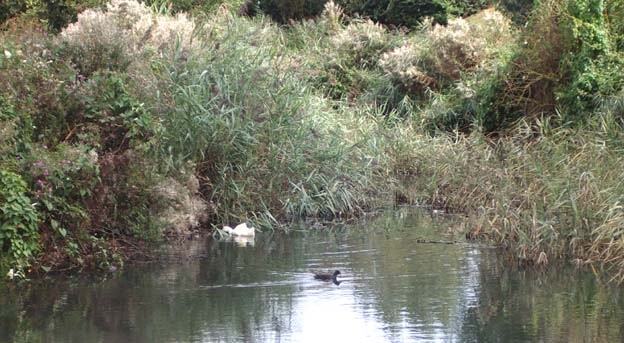
The
Stream feeding Brooklands
There
were the usual plentiful 50+ Coots on
the main body of the lake, but I only spotted one Moorhen
in the upper reaches.
Astronomy
Mars
comes
closer to the Earth at 34,646,418 miles at 10:51
am
than for any time since 56,617 BC. It rose
in the Sussex night sky about 9:00 pm
and could be seen low in the south reaching its highest point at 1:00
am.
Guardian
Report
24
August 2003
A
flock of about one hundred Goldfinches
filled the sky around New Salts Farm, Lancing, (south of Shoreham Airport)
late this morning.
22
August 2003
There
are scores, probably hundreds, of large grey moths around in the undergrowth.
At least some of these are the Silver Y
Moth, Autographa
gamma.
 20
August 2003 20
August 2003
After
the exceptionally hot spell, there was a slight autumnal feel to the air.
The
second brood Adonis
Blue Butterflies are now out and flying
around in their brilliant blue on the lower slopes
of Mill Hill. One even ventured up amongst the
the brambles and long grasses immediately
south of the reservoir on the upper slopes.
The count was 25+ (all males) and I was careful to avoid counting the same
butterfly
twice and to exclude the Common Blue Butterflies
in the total. The Small Heath Butterflies
exceeded
a hundred mostly on the lower slopes, but also extending on to the ridge
in the only area explored south
of the reservoir.
Full
Report
Butterfly
List 2003
19
August 2003
There
were over a hundred birds on Brooklands Boating Lake (see
the entry below) and the Coots,
Mallards
and Black-headed Gulls
all appeared to be in fine fettle. A dozen Martins
were swooping around the island. These martins appeared very brown
and they were probably Sand Martins?
(They were too far away to be absolutely sure.)
17
August 2003
The
Common
Carder Bee,
Bombus
pascuorum, was discovered in a Shoreham town garden.
Full
Report
15
August 2003
I
arranged to meet Andy
Gattiker of the South
Downs Conservation Board (SDCB) on Mill Hill.
The SDCB were attempting a public consultation to justify their management
decision to introduce a winter grazing of Limousin/Angus
cross cattle (standard beef cattle) on
Mill Hill. The grassland was very parched with few butterflies
in flight.
Full
Report including Butterflies
14
August 2003
 The
Shoreham
Herald reports that Brooklands
Boating Lake is again closed because of the mysterious deaths of both
resident and visiting birds including six
Mute
Swan cygnets, two Coots, nine ducks and one gull. The
cause is till unknown. A toxic blue-green algae and botulism have
been suspected as well as polluted silt in the lagoon. The smelly problem
occurs in late summer when the temperatures are at their warmest.
The water in Brooklands is mostly fresh stream-fed water, and is shallow
without any appreciable water plants. The
Shoreham
Herald reports that Brooklands
Boating Lake is again closed because of the mysterious deaths of both
resident and visiting birds including six
Mute
Swan cygnets, two Coots, nine ducks and one gull. The
cause is till unknown. A toxic blue-green algae and botulism have
been suspected as well as polluted silt in the lagoon. The smelly problem
occurs in late summer when the temperatures are at their warmest.
The water in Brooklands is mostly fresh stream-fed water, and is shallow
without any appreciable water plants.
Blue-Green
Algae Toxicity in Waterfowl
The blue-green
algal toxins can be harmful to humans and pets, and can be transmitted
by pet dogs. Death in waterfowl can be rapid with the species of algae
that produce neurotoxins (including anatoxins). There are various different
blooms of algae, all of which are encouraged by eutrophic water conditions.
Botulism has
also be found to be the cause of fatal disease in ducks in British town
parks.
Archives:
Sewage Pollution (Brooklands)
Archives:
Pollution Scare (Brooklands)
13
August 2003
The
seawater is flooding into Widewater Lagoon
through the new pipe inlet on the
high (over 6 metre) spring tides. It
will be interesting to observe the effect of the artificially raised water
level on the colour and prevalency of the saltmarsh plant Glasswort,
Salicornia.
The lagoon is at winter flood levels, at least equal to the highest level
known for Widewater in winter.
12
August 2003
A
count of eleven Little Egrets
on the River Adur by Shoreham Airport between
8:20 pm and 8:50 pm must be a new record.
One or two is usual, four exceptional, but only seven of the birds were
in view at the same time.
Adur Estuary
10
August 2003
The
air temperature in the shade did not quite make to hot today, the warmest
attained was 29.9° C at 3:30 pm before the clouds came over and at
just before 4:00 pm in a temperature of 27.5° C, it started raining.
This was the first rain of August. It lasted for a few minutes and then
it stopped. The humidity was 3:30 pm was 53%. The Heat Index was calculated
at 31.4° C (greater than the local hottest day).
The night temperature was warm falling only to 24.8° C at midnight.
Record
British temperatures at 38.1° C
8 August
2003
A
woman brought in a Death's
Head Hawk Moth caterpillar to Woods Mill
(Small Dole), found in her garden at Lancing, a pretty amazing beast all
in all. It was found in a Jasmine bush. This is a rare occurrence for the
caterpillar to be found in Britain.

Death's Head Moth from
Dorset
Photograph
by Ivan
NB:
The Death's Head Hawk-moths have been discovered before as immigrants (hearsay
reports) but not during the period of these Nature Notes (since 1997).
Death's
Head Hawk-moth Caterpillar Images
7 August
2003
My
south Lancing garden (TQ 186 044) was
awash with Silver 'Y' Moths
this evening at around sunset. There were about 30 or more in the garden.
On
the Hardy Plumbago I caught sight of a Hummingbird
Hawk Moth, Macroglossum
stellatarum, my first this year.
My
first Clouded Yellow Butterflies seen
on Mill Hill this year, flew strongly over the
lower
slopes. There were at least three, possibly five of these bright yellow
immigrant butterflies.
Full
Report
Adur
Butterflies Slide Show
6 August
2003
I
was buzzed repeatedly by a magnificent Emperor
Dragonfly in the butterfly
copse (TQ 209
063) near the Waterworks Road. This predator
looked capable of tackling the butterflies that visited the Buddleia.
Reports
of Dragonfly Predation on Butterflies (UK Dragonflies)
Adur
Dragonflies
Adur
Dragonfly Flight Times
 The
pretty little day-flying pyralid moth known as Pyrausta
aurata, were attracted to their caterpillar food plant Water
Mint in Ray
Hamblett's south Lancing garden. The
pretty little day-flying pyralid moth known as Pyrausta
aurata, were attracted to their caterpillar food plant Water
Mint in Ray
Hamblett's south Lancing garden.
The
overnight air temperature only fell to 23.7° C at
6:30 am so this was an exceptionally warm
night with the temperature at midnight of 24.8° C, rising to 25.4°
C at 2:30 am. The
humidity rose and at 8:30 am
it was 70% producing a faint mist. This mist seemed to keep the temperature
down to a maximum 26.8º C throughout the day. The Heat Index was calculated
at 28.5° C.
Heat
& Humidity Index
Heat
Index Calculator
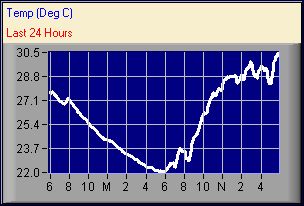 5
August 2003 5
August 2003
It
was the hottest day of the new millennium when the air temperature reached
30.6° C (87.1° F) at 5:54 pm
with a gentle breeze from the east. Humidity fell to 39% so it was quite
pleasant outside. I measured an air temperature in the shade of 30.5°
C at 6:45 pm in Shoreham town (the Shoreham beach temperature was 30.4°
C at this time). The Heat Index was calculated at 30.2° C.
Local
Climatology
Not
surprising with the warm weather, many people who are not at work and children
on holiday made their way to the beach where the
estimated sea temperature was 19° C, possibly rising to 21° C inshore
over sand. Weever
Fish are around and there were several
reports of people being stung by this fish that lives in the sand with
its venomous black dorsal fin sticking above the surface on which the bather
may have the misfortune to step on.
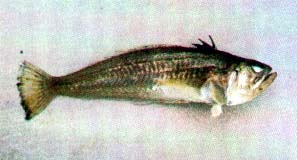
After
being sting by large Weevers
the pain is described as excruciating for the first two hours after which
it subsides and rarely causes permanent injury. The pain can be relieved
by immersing the foot in hot water at 40° C. This fish is common on
sandy coasts all around Britain.
Beware
of the Weever Fish
Sussex
Marine Life Reports
4 August
2003
Widewater
Lagoon is being maintained at a winter high level by allowing seawater
in through the inlet pipe, maintaining a salinity
of full strength seawater. A
handful of Common
Blue Butterflies fluttered over the shingle,
the reduced overflow of the flood plain because of the raised level, and
an Emperor
Dragonfly flew at about six metres above
the surface.
Widewater
Salinity
3
August 2003
Guided
Butterfly Walk
Friends
of Lancing Ring arranged for expert Brianne Reeve of the Butterfly
Conservation group to lead a walk over the Lancing
Ring Nature Reserve.
Ten
different butterflies were seen before
we left the car park.
 There
was a screech and a magnificent view of a Sparrowhawk
flying overhead, being mobbed by a Crow,
the pale blue-grey body of the raptor distinguished against the cloudless
sky. The first butterfly to make an appearance was a Green-veined
White, and then there was a steady variety
noted by a dozen or more immigrant Clouded
Yellows, a large handful of Chalkhill
Blues, far outnumbered by Common
Blues, and the hard to spot Wall
Browns. More eyes are better than a single
pair, and I might overlooked nearly a hundred Swifts
high in the sky. There was sharp call and a Green Woodpecker flew
over at lower end of the meadows, leaving the clump across the meadows
to the back garden of a house backing on to the Nature Reserve. There
was a screech and a magnificent view of a Sparrowhawk
flying overhead, being mobbed by a Crow,
the pale blue-grey body of the raptor distinguished against the cloudless
sky. The first butterfly to make an appearance was a Green-veined
White, and then there was a steady variety
noted by a dozen or more immigrant Clouded
Yellows, a large handful of Chalkhill
Blues, far outnumbered by Common
Blues, and the hard to spot Wall
Browns. More eyes are better than a single
pair, and I might overlooked nearly a hundred Swifts
high in the sky. There was sharp call and a Green Woodpecker flew
over at lower end of the meadows, leaving the clump across the meadows
to the back garden of a house backing on to the Nature Reserve.
Eighteen
species of butterfly were seen on the one and half walk around the meadows.
The last one of the list was a Peacock
Butterfly as we departed. This
total of eighteen was the most species I have seen in one day.
Full
Report 2003
2002
Walk Report
Adur
Butterflies
In
the horse's field under the A27 flyover (west side of the Steyning road,
south of the large roundabout) north of Old Shoreham, one hundred Black-headed
Gulls congregated. This may be the advanced
sortie after the annual explosion of flying
ants.
There were 25 large Herring Gulls
padding about on the Lancing Manor lawns
as well.
In
an Old Shoreham garden (Frampton's Court) a strange moth with two pairs
of dragonfly-type wings flew rapidly from one plant to another, never settling,
very fascinating as it rapidly dipped its proboscis
into each flower before buzzing off to another nectar source. This was
the Hummingbird Hawk Moth, Macroglossum
stellatarum, an occasional immigrant.
Moth
Report by Mike Burtt
Images
of the Hummingbird Hawk Moth (External Web
Site)
2 August
2003
Scores
of Large White Butterflies
have emerged on in the urban Shoreham area and on Shoreham beach, and as
well as most of the usual butterflies of the last week, a Brimstone
settled on a Buddleia flower in the butterfly
copse (TQ 209
063) near the Waterworks Road. The
steep west-facing parched slopes of Mill Hill were alive with Chalkhill
Blues. In one standing viewpoint, at least 30, often more, butterflies
could be seen in a two metre radius of the static position. Fourteen
butterfly species were seen in the bright sunshine with the glare on the
digital camera screen and the long shadows not inimical to photography.
All the butterflies were flighty and would
not settle.
White
Butterflies

31 July
2003
 There
were 67 Mute Swans
and one Australian Black Swan on
the river at low tide south of the Toll Bridge and visible from the riverbank
by Adur Metal Works. Four of the Mute Swans
could be seen by Adur Recreation Ground under the Railway
Viaduct. There
were 67 Mute Swans
and one Australian Black Swan on
the river at low tide south of the Toll Bridge and visible from the riverbank
by Adur Metal Works. Four of the Mute Swans
could be seen by Adur Recreation Ground under the Railway
Viaduct.
First
impressions seemed to indicate an even greater influx of Painted
Lady Butterflies than yesterday as a half
a dozen danced around one Buddleia
bush on the cyclepath south of the Toll Bridge. The
predominant breezes were averaged from 225° azimuth
(SSW). I did not explore further, but
there were the reddish Small Tortoiseshell
Butterflies, one Large
Skipper,
Large
Whites and the usual Gatekeepers
and Meadow Browns.
The
butterfly
copse (TQ 209
063) near the Waterworks Road
added Red Admirals,
a Comma,
a Peacock Butterfly,
and the first settled Holly Blue
of the second brood this year. The path to Mill
Hill added a Small White
and another Large Skipper.
The
A27 embankment south-east of the Mill Hill bridge produced a dozen Common
Blues, including females,
and one male Chalkhill Blue.
Then after 45 minutes, it began to rain.
That
was thirteen species of butterfly on a small
detour.
 30
July 2003 30
July 2003
On
an overcast, cool, with brief sunny spells, light rain at times, it would
be thought of as unpromising day for butterflies.
However,
the whole of the lower slopes of Mill
Hill were alive with the amorous flutterings of an estimated 2,000
+ Chalkhill Blue Butterflies reaching
densities of three every square metre (two males and one female) on plenty
of occasions. The lower slopes cover nearly five acres of ground so the
estimate is a conservative one. This year, the numbers must approach the
historic records of thousands of Chalkhill
Blues reported in the past.
Altogether
on Mill Hill and its approaches there were seventeen
different species of butterflies, a new record in one day for me.
An unusual second brood Dingy Skipper
was recorded on the lower slopes. This butterfly was clearly viewed and
there was no possibility of a mistake.
 The
prevalence of immigrant of brightly coloured Painted
Lady Butterflies (40+) on the footpath
through the Lancing Ring meadows with the new
reddish Small Tortoiseshells (25+)
leaves me to speculate that the Small Tortoiseshell
Butterflies were immigrants as well, although
north of The Street, Old Shoreham, a normal
orange livery specimen was noted. Casual visitors
to the approaches of Mill Hill and visitors to Lancing Ring should not
mistake the hundred plus Common Blue Butterflies
for Chalkhill Blues. Common
Blue Butterflies (100+) were found mostly
to the south of the A27. The
prevalence of immigrant of brightly coloured Painted
Lady Butterflies (40+) on the footpath
through the Lancing Ring meadows with the new
reddish Small Tortoiseshells (25+)
leaves me to speculate that the Small Tortoiseshell
Butterflies were immigrants as well, although
north of The Street, Old Shoreham, a normal
orange livery specimen was noted. Casual visitors
to the approaches of Mill Hill and visitors to Lancing Ring should not
mistake the hundred plus Common Blue Butterflies
for Chalkhill Blues. Common
Blue Butterflies (100+) were found mostly
to the south of the A27.
Butterfly
List (Species Recorded)
Blue
Butterflies of Shoreham
Adur
Butterflies
 28
July 2003 28
July 2003
On
the town side of the bridge leading to Mill Hill
that transverses the main A27 road, on the east there is a small Hawthorn
copse (at the top of Chanctonbury drive, north side) leading to the
grasses of the trunk road steep bank. In this small garden sized plot of
long grasses and scrub, two species of blue butterfly congregated sometimes
fighting over the same grass head. On this cool, overcast and windy day,
the commonest Common Blue Butterfly
(20+) seemed very small compared to at least one, probably three or four
of the larger Chalkhill Blue,
together with Meadow Browns
(6+) and Gatekeepers
(3+). I originally thought that Brown
Argus Butterflies were present but the distinctive
brown-blue-brown
colour
is now probably the female Common Blue Butterfly
as closer examination of the photographs seemed to indicate the latter
butterfly.
Fourteen
different species of butterfly were seen on Mill Hill.
Identification
Notes about the Brown Argus
Mill
Hill proper added extra species in Red
Admirals (2+), Painted
Ladies (5+), Wall
Browns (6+), Small
Heaths (4+), a Marbled
White, a Holly
Blue (by the garden hedge just north of
the bridge), a least two of the reddish Small
Tortoiseshells and more Chalkhill
Blues (40+).
Approaches
to Mill Hill Report
Butterfly
List (Full Report)
Blue
Butterflies of Shoreham
Adur
Butterflies
27
July 2003
There
were 500+ Meadow Brown Butterflies
seen with thirteen
or fourteen other butterfly species including three
Clouded
Yellows and a handful of Chalkhill
Blues seen on the southern meadows of
Lancing Clump. A Wall Brown Butterfly
showed an unusual faded colour. The majority of the butterflies were seen
in my first walk between
1:00 pm and 2:00
pm.
Long-winged Conehead Crickets were
also seen. A tatty male Chalkhill Blue was
photographed.
Full
Report
Full
Report with supplement
Friends
of Lancing Ring
 The
fresh crop of Small Tortoiseshell Butterflies
have appeared are
exceptionally reddish in colour. Hundreds
of Hoverflies,
Episyrphus
balteatus, make their annual appearance.
With their maroon head a wasp-like abdomen it is easy to understand why
they are christened the Marmalade
Fly. The
fresh crop of Small Tortoiseshell Butterflies
have appeared are
exceptionally reddish in colour. Hundreds
of Hoverflies,
Episyrphus
balteatus, make their annual appearance.
With their maroon head a wasp-like abdomen it is easy to understand why
they are christened the Marmalade
Fly.
Adur
Hoverflies
24
July 2003
The
bright yellow with an unmistakable lining of black was immediately recognised
as the first immigrant Clouded Yellow Butterfly
of the year in the lower meadows of Lancing Clump.
It was flying around energetically. The day was noted for large numbers
of Red Admiral Butterflies (50+) and
many of these may have been immigrants as well. Two more butterflies not
recorded with the fifteen species
yesterday were a single Peacock
Butterfly feeding on Teasel by the Waterworks
Road, Old Shoreham and the resident Comma
Butterfly in the nearby copse (TQ
209 063) with a Holly Blue.
The magnificent sight of the green thorax and dark blue body (abdomen)
of the male Emperor Dragonfly
was something to behold. Several of them frequented the Waterworks Road.
A bright red male Common Darter was
over the thistle-covered field by the Steyning
Road (TQ 209 068).
The
Teasel on the cycle path
from Shoreham to Upper Beeding attracted three chirms of Goldfinches
of
about a dozen birds each, a colourful sight on a breezy day.
Thirteen
species of butterflies were seen and had I visited Mill
Hill, I would have broken my record for species of butterflies
on a single day. It seems that Small White
Butterflies were not to be seen.
Butterfly
List
 23
July 2003 23
July 2003
A
Brown
Argus Butterfly was a surprise discovery
on the Slonk Hill A27 southern embankment
(TQ
228 067). This is a small butterfly and despite
its brown colour, when flying it looks dark blue.
It
is the first record of a Brown Argus
on these Nature Notes pages.
Accompanying
butterflies included
Meadow Browns,
Gatekeepers,
Red
Admirals, Large Whites, one
Speckled Wood,
Large
Skippers and a
few Chalkhill Blues.
The
bank contains a few clumps of Horseshoe Vetch,
the food plant of the Chalkhill Blue
caterpillars. A dozen female (or juvenile) Common
Darter Dragonflies in an orange-brown
livery were amongst taller vegetation. The grasshopper
on the bank was grey-brown without a clear
glimpse of green.
A
Holly
Blue Butterfly was seen at the top of
Buckingham Park.
About
fifty Common Blue Butterflies roosted
on a small clump of Cocksfoot in the north-west corner of the horse's field
at the top of the Street, Old Shoreham, by the footpath to Mill Hill.
Later
in the afternoon the day's tally of butterflies was increased to fifteen
with the additional sightings of Marbled
Whites,
Painted
Ladies, Wall
Browns,
Small
Heaths and just one Small
Tortoiseshell.
Adur
Butterflies
A
male worker of Vestal Cuckoo Bumblebee,
Bombus (Psithyrus)
vestalis, nectared on a Scabious.
21
July 2003
 Fifteen
different species of butterflies in a single
day is a new record for me and included 200+
Chalkhill
Blues on the lower
slopes of Mill Hill. Fifteen
different species of butterflies in a single
day is a new record for me and included 200+
Chalkhill
Blues on the lower
slopes of Mill Hill.
Chalkhill
Blue (200+)
Meadow
Brown (100+)
Gatekeeper
(90+)
Large
Skipper (15+)
Common
Blue (10+)
Red
Admiral (4+)
Large
White (3+)
 Painted
Lady (2+) Painted
Lady (2+)
Wall
Brown (2)
Marbled
White (2+)
Small
Heath (1+)
Small
White (1+)
Small
Skipper (1+)
Speckled
Wood (1)
Comma
(1)
Brown
Argus (1) REJECTED
Butterfly
List
20
July 2003
Midday
 Over
300
Chalkhill
Blue Butterflies
were observed fluttering around and copulating on the lower
slopes of Mill Hill and they were to be
seen on the sunny day at a conservative average of one butterfly
every two square metres. At this prevalence, I got the impression that
I was constantly about to step on one. My estimate
for the number of Chalkhill Blues
on Mill Hill was 1,200. Over
300
Chalkhill
Blue Butterflies
were observed fluttering around and copulating on the lower
slopes of Mill Hill and they were to be
seen on the sunny day at a conservative average of one butterfly
every two square metres. At this prevalence, I got the impression that
I was constantly about to step on one. My estimate
for the number of Chalkhill Blues
on Mill Hill was 1,200.
Butterfly
Transect Method
Butterfly
List (Full Report)
Early
Evening Supplementary Report
Adur
Butterflies
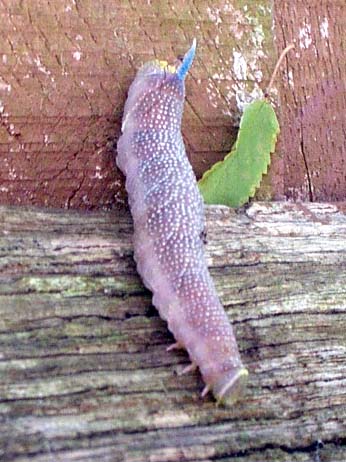 19
July 2003 19
July 2003
We've
just discovered a large caterpillarin
our east Shoreham garden. It was about 5 - 6 cm long, grey with a 5 mm
blue horn or spike on its back at the rear. Its fairly smooth and looks
like a slug with legs.
Ray
Hamblett has identified the larva as that of the Lime
Hawk-moth, Mimas
tiliae.
The
photograph was enhanced by Andy Horton so I do not know if the colours
are true?
UK
Moths
Chalkhill
Blue Butterflies on the Waterworks Road,
Old Shoreham numbered at least five males and they could be seen immediately,
on the margins amongst the ferns, just north of where the road passed under
the A27 Flyover.

At
least one, almost certainly more, Wall
Brown Butterflies were seen amongst vegetation
including Fleabane
on the cyclepath on the east side of the River Adur
from Old Shoreham northwards.
Butterfly
List
18
July 2003
There
are loads (probably over a thousand) of Moon
Jellyfish, Aurelia
aurita, in Shoreham harbour, with
the
four pink rings (the gonads)
visible in many specimens.
The
combination of the high tides and the new inlet pipe have resulted in Widewater
Lagoon being in flood comparable to winter. The flood
plain wild flowers (weeds) are under threat from the saline conditions,
possibly including the Sea
Heath, Frankenia
laevis.
17
July 2003
The
humidity
peaking at 92% is a high figure, possibly a record new millennium figure
for the summer months as the dawn temperature drops to 18.2 ºC with
a drizzle and overcast sky. This weather could be described as "muggy".
The indoor temperature in my office remains at an unpleasant 30 ºC.
15
July 2003
St. Swithun's
Day
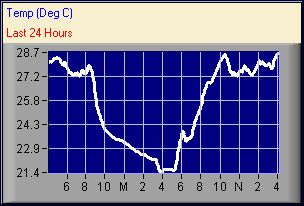
A record
temperature for the new millennium on Shoreham beach, 28.6 ºC was
reached by 10.28 am. Just after 4:00 pm 28.7 ºC was attained and this
exceeds any other shade air temperature since the records began at the
start of 2000.
My
low accuracy mercury thermometer measured at outside shade temperature
near Shoreham town at 5:45 pm at 28.0 ºC compared to the recorded
Shoreham beach figure of 28.5 ºC.
 14
July 2003 14
July 2003
The
appearance of four large Long-legged
Spider Crabs on Kingston Beach was unexpected,
although they have been caught in July before. The largest specimen measured
18 mm from the rear of the carapace to the eyes but the spread of legs
and claws was 100 mm. Two Moon Jellyfish,
Aurelia
aurita, were seen.
 14
July 2003 14
July 2003
There
was not a single cloud in the bright blue sky, not the faintest white wisp
in the late afternoon. At 5:00 pm the
shade temperature was recorded at 28.4 ºC, with a gentle breeze from
the north-east, veering south-east after
10:00
am, it is the warmest day of the year, and
the warmest day recorded by the since 29 July
2002 when 28.5 ºC was recorded, the highest
this millennium since the local records began. In the hours before dawn
it falls to a pleasant 18.8° C. The temperature at midnight beginning
the day was 20.1 ºC. The temperature indoors at my home office rose
to 31 ºC and remained at that temperature into the night. The closing
midnight shade temperature was 23.3 ºC. In 1990, a temperature of
37.1ºC was recorded in Cheltenham, Gloucestershire.
14
July 2003
Time
and heat (28.4 ºC) allowed
just a brief detour down the Old Shoreham Waterworks Road, where the butterflies
in order of appearing were a Large Skipper,
a darker oil painting-style Small Tortoiseshell
Butterfly, a brown coloured Comma
that
settled on my bicycle, followed by about dozen Large
Whites, with probably some Small
Whites as well, up to a score of mostly
male Meadow Browns,
and at least one Gatekeeper.
A Chalkhill Blue
was confirmed on a thistle
amongst the nettles nearer the Waterworks house where the stream running
alongside the road had dried up. A handful of very blue Common
Blue Butterflies, just one Red
Admiral in the copse (TQ
209 063) leading to The Street, a handful of Small
Skippers and one bright Painted
Lady completed a surprisingly high tally
in just half an hour on the edge of town.
Total
= 12 species
Tortoiseshell
Colour Liveries
The
Chalkhill
Blue on the Old Shoreham Waterworks Road was
a notable sighting. This is the first one this millennium on this rarely
visited private road. In the 1970s the grass was mown and this was a notable
area for Chalkhill Blues
with hundreds (up to 250) frequently seen on the short grass, which was
not a huge nettle patch as it is now.
Butterfly
Report
Adur
Butterfly List (from 14 July 2003) not recorded on Nature Notes
 11
July 2003 11
July 2003
On
the lower slopes of Mill
Hill, at least fifty Chalkhill Blue
Butterflies were flying about and not
settling for long. Only a handful were on the middle
and upper slopes. The Stemless Thistle
was in flower, that prickly rosette that is a characteristic and slightly
uncomfortable feature of the chalk sward. In the middle of the day the
miniature Eyebrights
show best and are ideally viewed through a magnifying glass. Pyramid
Orchids were frequently seen in the central
area known as the Triangle.
 Full
Report Full
Report
Adur
Butterflies
On
a sunny day the temperature peaked at 26.6° C.
Down
on the Adur Levels,
in the thistle jungle between the Steyning Road and
the Waterworks (TQ 209 068) a
bright
red male Common Darter Dragonfly in
breeding livery was impressive. A Moorhen
clattered up the stream and the incongruous sight was a Great
Spotted Woodpecker overhead, flying for
the nearest tree.
10
July 2003
On
New Monk's Farm, Lancing there were over a hundred Small
Skippers seen, with some Large
Skippers. plus a handful of Meadow
Brown Butterflies and just a single Small
Copper Butterfly.
The
ecology of Widewater Lagoon seems to be changing.
One filamentous green weed, probably Cladophora
is missing and the large shoals of 3-spined Sticklebacks, Gasterosteus
aculeatus, which were one of the most obvious and easily recognised
feature of Widewater for the last fifty years or more, are no longer
to be seen and seem to have been replaced by small prawns. In the last
week, several huge metre long Eels,
Anguilla
anguilla, were seen in the small pool near the input pipe thrashing
about in the muddy shallows. The width of the bodies were larger than could
be grabbed in one hand.
Widewater
Report by Russell (Lancing)

The
resident Little Egret
was repeatedly feeding in the shallows, but I attempted to but I could
not identify what it was feeding on. There was not an abundance of prawns
in its feeding area.
A
Common
Blue Butterfly fluttered around the bushes
by the riverbank where the main drag of houseboats are. (This butterfly
behaved like and was originally thought to be a Holly
Blue, but it was probably too early for the
second brood.)
9 July
2003
Night
Dive
Fifty
young Cuttlefish,
Sepia
officinalis, merged from their black egg cases in shallow water
by the Brooklands outfall pipe. A large Little
Cuttlefish, Sepiola atlantica,
was feeding on a worm and then a beautiful Squid
danced
in front of my torch. There were many Eels
and
Bass
amongst an amazing variety of juvenile fish: Bib
(Pouting), Plaice, Sole,
and
Pollack.
5
July 2003
Evening
We
dived off of the Church of the Good Shepherd, Shoreham Beach, in an area
we are familiar with. There were areas that appeared like the chalk bedrock
was exposed under the sand but on closer inspection was white sand? The
Ragworm
casts were an unusual marbled mixture of colours. The reef there was particularly
stony last October 2002,
but now we only see a few pebbles. The "weed" growth is still in the same
area.
We
saw two Common Eels
but they were buried in the sand with just their heads sticking out. I
have never seen this behaviour before. Whilst photographing the EelsI
discovered that the sand was in fact a soft black mud which you could push
your whole hand into, easily up to my wrist. The Eels
were up to a metre in length.
We
saw only two young Undulate Rays.
We also saw a juvenile Lumpsucker
10 mm long. with some Plaice, Sole,
female Corkwing
Wrasse, and a beautiful shoal of silvery
herring or sprats (40 mm long ). My buddy helped a baby Cuttlefish
escape from its small black egg.
Three
species of sea anemone were spotted: many Sagartia
troglodytes, Dahlia Anemones
(10) and two Snakelocks Anemones. At
a depth of four metres, the sandy areas within the weed had many exposed
Sand
Mason worms but the sand appeared as if
it had been "brushed" all in the same direction. There were Edible
Crabs and large Shore
Crabs, and a display of the attractive
Peacock
Worms, but on the whole the reef was fairly lifeless compared to other
dive sites off the Sussex coast.

Afternoon
My
first (female) Common Darter,
Sympetrum
striolatum, of the year, displayed on the vegetation next to the
stream (TQ
209 068) on
the Adur flood plain north of Old Shoreham. This
species is possibly the commonest and most widespread of the British dragonflies.

Just
one white
butterfly
made an immediate appearance. The black markings
especially on the edge of the wings were particularly marked on this butterfly
which made me think it was a Large
White Butterfly, but subsequent observation
of Large Whites have
now made me identify this butterfly as the Green-veined
White.
Full
Report
Morning
There
are a lot of small black insects around, especially the flies by Widewater
Lagoon. Over Lancing town centre near the railway station, at least
three
Swifts,
screeched and swooped low over the rooftops. Swifts
could also be found over Hamme Road Allotments, Shoreham-by-Sea.
 3
July 2003 3
July 2003
On
a humid and overcast day, in the Butterfly Copse, (TQ
209 063), where the footpath leaves the Waterworks Road for Mill
Hill, there was just one Comma Butterfly.
I disturbed my first Emperor Dragonfly
of
the year, distinguished by its large size. Mill Hill produced Marbled
White (20+) and Meadow
Brown Butterflies (20+), plus the first
Gatekeepers.
Adur
Butterflies
1 July
2003
The
Environmental
Agency opened up the four inch slats and three workers (in two vehicles)
supervised the input of seawater into Widewater
Lagoon on the high spring tide. Despite this
topping up the lagoon, the water level was still fractionally down compared
to
11 June 2003.

The
specific gravity was measured (and double-checked) and the salinity calculated
at 35‰ (ppt), which is full strength seawater. This compares to a salinity
of 24‰ (ppt) in July 2002. A combination of the input of full strength
seawater and the evaporation during the exceptionally hot spell this spring
is likely to be the reason. If the fresh seawater is introduced throughout
the summer at the current rate, the lagoon will become too hypersaline
and be unable to support aquatic life.
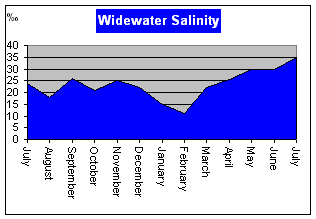
Widewater
Salinity Records 2002-3
Widewater
Flood Plain

Viper's
Bugloss and Opium
Poppies
on
the Widewater Flood Plain
Notes:
Wind
Direction (degrees azimuth)
The value
0° means North.
The value
90° means East.
The value 180° means
South.
The value 270° means
West.
|


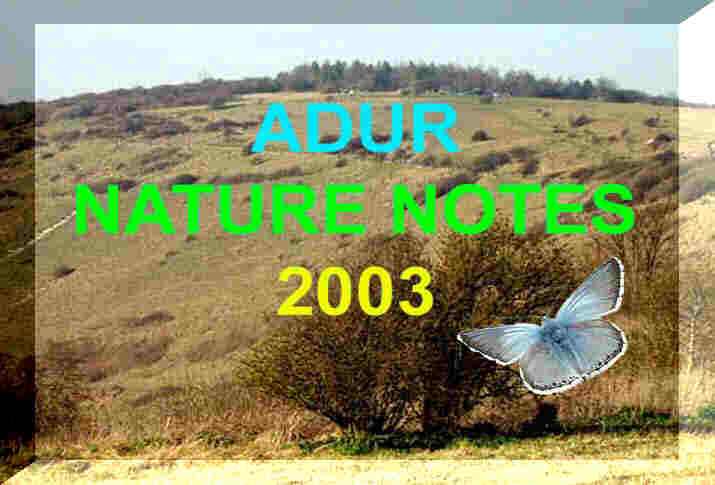


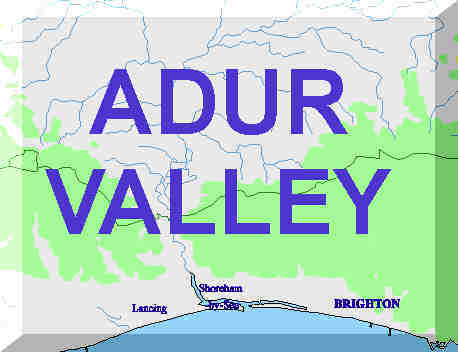

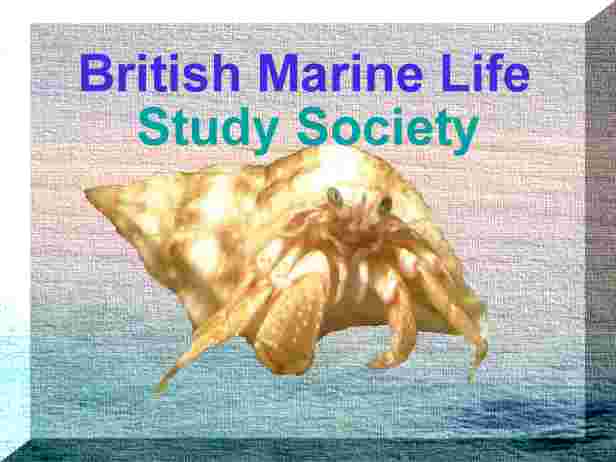
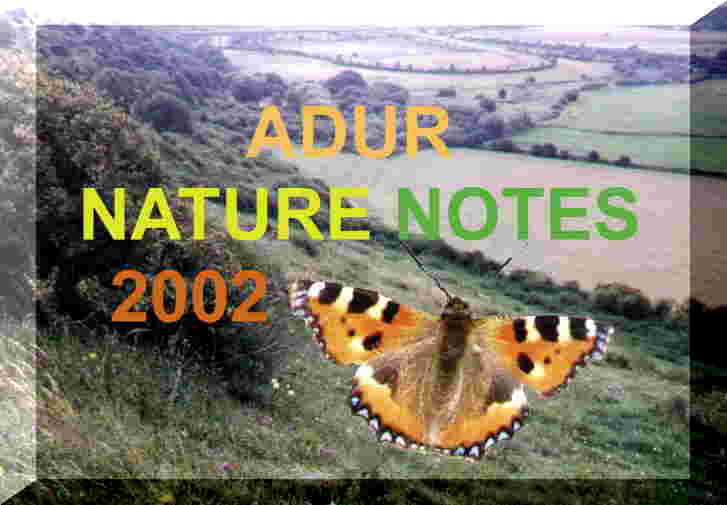




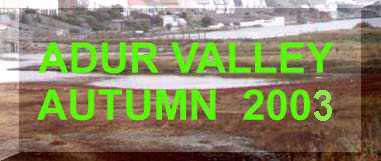










 The
The











 19
July 2003
19
July 2003












